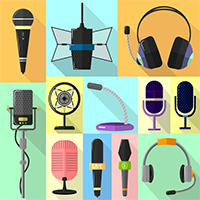Blog, Business Development, Creating Wealth, Leadership, Podcasting
Questions to Ask to Evaluate and Manage Your Ideas
Too many ideas? Shiny ball syndrome? Ask yourself these questions to evaluate and manage your ideas and find the right actions to take to ensure success
 I’m a creative person, as many of you are, and I have always dealt with the problem of having a large number of ideas all the time. I call it a problem because that’s what it was before I really learned how to start wrangling all my thoughts and turning them into productive ideas rather than getting caught in the “shiny ball syndrome” that takes us away from the things we need to be focusing on in order to produce the results that we keep saying we want.
When we’re looking at any idea, we have to bring it outside of ourselves. Examine it like you’re examining a physical object. Look at all the parts: What do you like about it? What about it has you absolutely enamored? What parts of it are causing you to hold onto it? What do you see about it that connects with the things that you’re thinking about doing or that you’re already doing? Will it slide in easily or take you in another direction? Is it a missing-piece-idea that fits in perfectly with what you have going on, or will it come into play later in the plan?
I’m a creative person, as many of you are, and I have always dealt with the problem of having a large number of ideas all the time. I call it a problem because that’s what it was before I really learned how to start wrangling all my thoughts and turning them into productive ideas rather than getting caught in the “shiny ball syndrome” that takes us away from the things we need to be focusing on in order to produce the results that we keep saying we want.
When we’re looking at any idea, we have to bring it outside of ourselves. Examine it like you’re examining a physical object. Look at all the parts: What do you like about it? What about it has you absolutely enamored? What parts of it are causing you to hold onto it? What do you see about it that connects with the things that you’re thinking about doing or that you’re already doing? Will it slide in easily or take you in another direction? Is it a missing-piece-idea that fits in perfectly with what you have going on, or will it come into play later in the plan?
Asking the Right Questions
Ask yourself these questions to evaluate and manage your ideas and find the right actions to take to ensure productivity and a serene and calm approach to your projects:- Will it make a current part of your plan easier?
- Will it make something better?
- Will it make something faster?
- Will it make something more profitable?
- Will it make it more enjoyable?
Putting Things into a GeoSync Folder
If the idea is one that you really don’t want to get rid of, but it doesn’t really fit into anything, you can put it into what I call a GeoSync folder. Think of yourself like a satellite, and you have ideas orbiting all around you. Turn this into a concrete idea, and create a GeoSync folder on your computer, Google Drive, or where ever you store your files. Keep track of your ideas, and review them every couple of months when you review your strategic vision plan. This way, they’re not taking up brain space or creating anxiety, but they’re also not disappearing into the ether that is lost thoughts and ideas.Capture & Release…of Ideas?
It’s important to start an Idea Capture and Release Program. We all know that ideas don’t always come to us at the most convenient times. If we’re being honest with ourselves, we realize that our best ideas usually don’t come to us when we're sitting behind a desk in an office, but rather when we’re using other parts of our brains and allowing our brains to be a little more free-thinking and creative. Where we get ideas is different for all of us, but the important part is to have a way to capture these ideas and not let them slip away. This is where habit-building comes in handy. Most of us having our phones with us nearly all the time. Use that to your advantage, and have a spot on your phone—either in your email or a note app—where you have a running list of ideas. Sync this with your GeoSync folder to bring your short-term thoughts of in-the-moment ideas that were captured, and combine them with your long-term stored ideas in GeoSync. Bill Gates famously said, “I keep my plate full at 60%.” The first time I heard this, it really surprised me because of the amazing enterprises he built. He left 40% of his time for thinking and creative time, reading, or writing. Although these things seem like idle activities on the surface, they are actually the life-blood of creativity and allow your plans and actions to be more streamlined and better aligned with one another. We have a tendency to get really caught up in the hamster wheel of day-to-day life and all the busyness that comes with it, so we will have to be really intentional about scheduling this Think Time into our calendar. When we allow ourselves time to let our brains get into a different mode, we can get a whole new set of ideas that we never would have thought of before. Need support for your ideas and help bringing them into reality? Some great resources are:- Facebook Group: Online Creators Launchpad
- Podcasts: Podcasters Hangout or She Podcasts (for us ladies with big ideas)
- Book Groups: Check out the groups that I belong to on Facebook and also check out Florida Writers Association if you’re in Florida

Create a Professional and Profitable Audiobook!
The Insiders Guide to Audiobook Production gives you the inside track to create a high-quality and effective audiobook and reach a much larger new audience.
Thank you!
Please check your inbox for your email.
If you don't see anything in a few minutes, please check your spam folder.
Recent Posts
2024 Staff Picks: Some Of Our Favorite Things
Tina Dietz writes about Twin Flames Studios' staff picks for the best nonfiction audiobooks of 2024. Explore behind-the-scenes insights and the tools that shaped our year!
How Vocal Delivery Shapes Leadership Perception in the 2024 Presidential Election
Tina Dietz writes about how vocal delivery plays a crucial role in shaping public perception, especially in the 2024 election. This article explores how candidates like Donald Trump and Kamala Harris use tone, pitch, and pacing to influence voters.
Why An Audiobook Now?
Tina Dietz writes about the power of audiobooks, the ability to intimately connect with an audience, and what misconceptions people hold around audiobooks.
